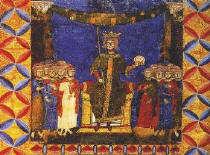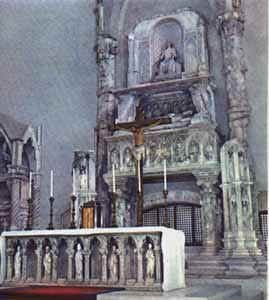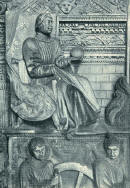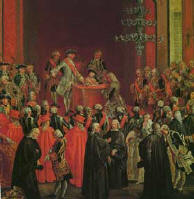|
|
According to the legend, The Parthenopean siren, gave its name to the city that rose around
its tomb; but, leaving out its myths and the more or less reliable hypothesis
on its origin, it is certain that Naples, born in the IV
cent. A.C. from the union of two ancient cities of Greek origin, Palepolis
and Neapolis - expanded during the Roman period, keeping for centuries
its unaltered character of a Greek city.Famous since the classical era,
it was praised by historians and poets, for its beauty and civilization.
Silio Italicus proclaims it "the hospitable room of the Muses"; Stazio
praises it "for the healthiness of its mild climate, its civil order,
for the studies which flourish on it, for the religion and the courtesy
of its customs"; Strabone compares it with the most cultured cities in
Greece; Virgil composed in it the "Georgiche" and desired to confirm his
grateful admiration also in connection with the cordiality with which
he was received. When the city became a Roman colony under the Empire,
it gradually grew in gymnasium, porticos, acqueducts, high graded schools,
new streets, tunnels and the Roman patricians made of it their preferred
sojourn, populating the coast with sumptuous villas, th e most celebrated
of which were those of Vedio Pollione at Posillipo and of Lucullus, and
the coast spread from the hill of Pizzofalcone as far as the Castello
dell'Ovo (Castle of the Egg). When the last Emperor of the West died within
the walls of Castro Luculliano, the city fell in its rank and was conquered
by the barbarians. It was placed under the protection of the Byzantines,
after having victouriosly resisted to the Longobards sieges in VIII century,
when it became the seat of a dukedom that knew how to preserve its autonomy
up to 1139, when it was annexed to the kingdom, founded by Ruggero II,
the Norman. When the Norman dynasty replaced the Suabian, its importance
diminnished, but it did not cease, since  Frederic II raised the city to an intellectual
capital of his kingdom, by founding a University for Studies, where among
teachers: Saint Thomas d'Aquino; Pier delle Vigne and Taddeo da Sessa
became famous. In 1266 with Carlo d'Angi˛, Naples was raised to the dignity
of capital of a kingdom to which Carlo d'Angi˛ gave his own name
and especially with Robert the Wise, the city awakened to a new life.
The population increased, sacred and civil buildings increased in number
and several colonies of Florentines, Lombards, Catalans and Provenšals,
established themselves in the city and gave a strong increase to the industries,
trade and commerce. Intrigues, tragedies, political fights determined
the fall of the Angiovin dynasty till 1442, when a new period of splendour,
under Alfonso, il Magnanimo, started for Neapolitan history and this lasted
until 1504, when all Southern Italy, brought down to the rank of a vice-kingdom,
was subjected to Spanish domination, exploited and overtaxed by the dominators,
Naples was forced to endure two centuries of slavery, nevertheless the
city, by terrible pestilences, continued to renew and expand itself, especially
during viceroy Pietro de Toledo's government (1532-1553) when important
works were carried out, among which the opening of a new street which
still bears his name and the widening of the city's walls. In 1734 with
the installation of the Bourbon dynasty, Naples rose once more to the
rank of a capital. The city owned its building development, as well as
the construction of monumental works to
Frederic II raised the city to an intellectual
capital of his kingdom, by founding a University for Studies, where among
teachers: Saint Thomas d'Aquino; Pier delle Vigne and Taddeo da Sessa
became famous. In 1266 with Carlo d'Angi˛, Naples was raised to the dignity
of capital of a kingdom to which Carlo d'Angi˛ gave his own name
and especially with Robert the Wise, the city awakened to a new life.
The population increased, sacred and civil buildings increased in number
and several colonies of Florentines, Lombards, Catalans and Provenšals,
established themselves in the city and gave a strong increase to the industries,
trade and commerce. Intrigues, tragedies, political fights determined
the fall of the Angiovin dynasty till 1442, when a new period of splendour,
under Alfonso, il Magnanimo, started for Neapolitan history and this lasted
until 1504, when all Southern Italy, brought down to the rank of a vice-kingdom,
was subjected to Spanish domination, exploited and overtaxed by the dominators,
Naples was forced to endure two centuries of slavery, nevertheless the
city, by terrible pestilences, continued to renew and expand itself, especially
during viceroy Pietro de Toledo's government (1532-1553) when important
works were carried out, among which the opening of a new street which
still bears his name and the widening of the city's walls. In 1734 with
the installation of the Bourbon dynasty, Naples rose once more to the
rank of a capital. The city owned its building development, as well as
the construction of monumental works to  Charles of the Bourbons. It became one of the most attractive metropolis
of Europe, the preferred place of illustrious Italian and foreign travellers:
from President Des Bosses to Wolfang Goethe. The example of the enlightened
government of Charles of Bourbon was not followed by his successors, who
were deaf to the voice of the new era and were overcome by the events.
In 1806 Bonaparte proclamed himself, King of Naples, and two years later,
Gioacchino Murat who succeeded him, was shot at Pizzo Calabro. During
the French domination, the city had a good period of prosperity and civil
progress and improved in the field of culture and economic reforms. But
when Ferdinand IV returned to the trone, his estrangement from the Bourbons
and the select part of the town, became always deeper and finally caused
the fall of the dynasty. On September 6, 1860, the last King of Naples,
Francis II sailed for Gaeta and from that day the vicessitudes of the
city were completely inserted in those of the Kingdom of Italy. After
its annexation, important works were carried out to renew the city end
to adapt it to its new needs. In 1884 entire sections were recovered;
subsequently new city sections were brought into existence as well as
new panoramic streets; the harbour was amplified; new schools; hospitals
and charitable and cultural institutions were opened. Factories, ship
building yards; railway stations; hotels and autoroads were added. Special
attention was given to repair the damages caused by time and the desctructive
fury os men, as well as to restore important monuments, that are the reliable
witnesses of history and the civilization rank of a nation. Unfortunately
the remains of monuments of the classical era are very rare and little
is left over of the artistic production of the centuries that follow.
To be acquainted with the monuments of the Bizantine - Longobards and
Norman-Swabian periods, one must go to Capua; to Sant'Angeli in Formis;
Caserta Vecchia; Ventaroli; Sessa Aurunca, but in the catacombs of San
Gennaro in Fonte, Naples has valuable documents pertaining to the history
of the first centuries of art and Christian civilization. With the accession
to the throne, Charles II of Angi˛ and especially with Robert the Wise,
as it has been said, the artistic revival of the city begins. French architects
who came as retinue of the Angiovins, built castles and churches which
Italian sculptors and painters from Giotto to Tino da Camaino embellished
with their works Castel Sant'Elmo, Castelnuovo, the Cathedral, the Churches
of San Lorenzo, Santa Chiara, Donnaregina, S. Eligio, San Pietro a Majella,
San Domenico Maggiore, l'Incoronata, belong to this period. Towards the
middle of the XV century with the Aragonese - while men of letters and
poets, such as : Panormita, Giovanni Pontano, Jacopo Sannazaro, who were
helped and encouraged by sovereign munifience, divulged with their work
a humanistic culture - Cataland artists from all part of Italy, came to
Naples, which grew rich with works of art and noble constructions such
as: the Arch of
Charles of the Bourbons. It became one of the most attractive metropolis
of Europe, the preferred place of illustrious Italian and foreign travellers:
from President Des Bosses to Wolfang Goethe. The example of the enlightened
government of Charles of Bourbon was not followed by his successors, who
were deaf to the voice of the new era and were overcome by the events.
In 1806 Bonaparte proclamed himself, King of Naples, and two years later,
Gioacchino Murat who succeeded him, was shot at Pizzo Calabro. During
the French domination, the city had a good period of prosperity and civil
progress and improved in the field of culture and economic reforms. But
when Ferdinand IV returned to the trone, his estrangement from the Bourbons
and the select part of the town, became always deeper and finally caused
the fall of the dynasty. On September 6, 1860, the last King of Naples,
Francis II sailed for Gaeta and from that day the vicessitudes of the
city were completely inserted in those of the Kingdom of Italy. After
its annexation, important works were carried out to renew the city end
to adapt it to its new needs. In 1884 entire sections were recovered;
subsequently new city sections were brought into existence as well as
new panoramic streets; the harbour was amplified; new schools; hospitals
and charitable and cultural institutions were opened. Factories, ship
building yards; railway stations; hotels and autoroads were added. Special
attention was given to repair the damages caused by time and the desctructive
fury os men, as well as to restore important monuments, that are the reliable
witnesses of history and the civilization rank of a nation. Unfortunately
the remains of monuments of the classical era are very rare and little
is left over of the artistic production of the centuries that follow.
To be acquainted with the monuments of the Bizantine - Longobards and
Norman-Swabian periods, one must go to Capua; to Sant'Angeli in Formis;
Caserta Vecchia; Ventaroli; Sessa Aurunca, but in the catacombs of San
Gennaro in Fonte, Naples has valuable documents pertaining to the history
of the first centuries of art and Christian civilization. With the accession
to the throne, Charles II of Angi˛ and especially with Robert the Wise,
as it has been said, the artistic revival of the city begins. French architects
who came as retinue of the Angiovins, built castles and churches which
Italian sculptors and painters from Giotto to Tino da Camaino embellished
with their works Castel Sant'Elmo, Castelnuovo, the Cathedral, the Churches
of San Lorenzo, Santa Chiara, Donnaregina, S. Eligio, San Pietro a Majella,
San Domenico Maggiore, l'Incoronata, belong to this period. Towards the
middle of the XV century with the Aragonese - while men of letters and
poets, such as : Panormita, Giovanni Pontano, Jacopo Sannazaro, who were
helped and encouraged by sovereign munifience, divulged with their work
a humanistic culture - Cataland artists from all part of Italy, came to
Naples, which grew rich with works of art and noble constructions such
as: the Arch of  Alfonso d'Aragona, the Pontano Chapel, Porta Capuana, the churches of
Sant'Anna dei Lombardi, San Giovanni a Carbonara, Palazzo Cuomo, The Palace
of Diomede Carafa, now known as the Palazzo Santangelo, Palazzo Guarino,
Palazzo Marigliano, the Church of Santa Caterina a Formiello, belong to
the first period of twenty years of the century. Other sacred and profane
buildings followed. These were embellished by several painters from Southern
Italy, such as: Andrea Sabatino, painter; Giovanni Mormanno, architect;
and Giovanni Merlian, sculptor, who distinguished themselves in their
marvellous work. In the last period of ten years in the 16th century and
the first half of the following century, artists from France or Catalogna,
who came down from Northern Italy, such as: Cosimo Fanzago, Giovanni Antonio
Dosio, Domenico Fontana, Francesco Picchiatti restored the old edifices,
and new constructions, such as the Royal Palace, the Certosa of San Martino,
the Palace of Studies and the Monte di PietÓ, were added to the city.
In the 17th century, Neapolitan art, does not only improve with churches
and princely houses, obelisks, spires, statues and fountains, but enriches
the streets and squares of the city. Under the new baroque cover, the
ogival arches in the old churches disappear, and so do the two fold light
windows and the severe altars. Plasters, volutes abuntant ornamental drawings,
marble drapings cover the naked and grey stones on the frescoes walls.
But if in this intense constructive activity, Naples did not contribute
with its own artists in the field of painting, it asserted itself with
genial works, by Battistello Caracciolo, Bernardo Cavallino, Massimo Stanzione,
Mattia Preti, Luca Giordano, and thanks to the dialy, productive activity
of these artists, Naples became one of the principal and more important
centres of the Italian artistic production in the 18th century. With artists
of the 18th century - Solimene, De Mura, Fuga, Sanfelice, Sammartino,
a new decorative taste was discovered, which prevailed in architecture
and in the f
Alfonso d'Aragona, the Pontano Chapel, Porta Capuana, the churches of
Sant'Anna dei Lombardi, San Giovanni a Carbonara, Palazzo Cuomo, The Palace
of Diomede Carafa, now known as the Palazzo Santangelo, Palazzo Guarino,
Palazzo Marigliano, the Church of Santa Caterina a Formiello, belong to
the first period of twenty years of the century. Other sacred and profane
buildings followed. These were embellished by several painters from Southern
Italy, such as: Andrea Sabatino, painter; Giovanni Mormanno, architect;
and Giovanni Merlian, sculptor, who distinguished themselves in their
marvellous work. In the last period of ten years in the 16th century and
the first half of the following century, artists from France or Catalogna,
who came down from Northern Italy, such as: Cosimo Fanzago, Giovanni Antonio
Dosio, Domenico Fontana, Francesco Picchiatti restored the old edifices,
and new constructions, such as the Royal Palace, the Certosa of San Martino,
the Palace of Studies and the Monte di PietÓ, were added to the city.
In the 17th century, Neapolitan art, does not only improve with churches
and princely houses, obelisks, spires, statues and fountains, but enriches
the streets and squares of the city. Under the new baroque cover, the
ogival arches in the old churches disappear, and so do the two fold light
windows and the severe altars. Plasters, volutes abuntant ornamental drawings,
marble drapings cover the naked and grey stones on the frescoes walls.
But if in this intense constructive activity, Naples did not contribute
with its own artists in the field of painting, it asserted itself with
genial works, by Battistello Caracciolo, Bernardo Cavallino, Massimo Stanzione,
Mattia Preti, Luca Giordano, and thanks to the dialy, productive activity
of these artists, Naples became one of the principal and more important
centres of the Italian artistic production in the 18th century. With artists
of the 18th century - Solimene, De Mura, Fuga, Sanfelice, Sammartino,
a new decorative taste was discovered, which prevailed in architecture
and in the f igurative arts that are put into relation to the character and importance
of the pompous architectonic organism. In the new unusual fronts of the
lordly palaces, extra plaster is added to the cornices. There are wide
and magnificent courtyards, colonnades, sumptuous and fanciful staircases
and an ornamental taste, full of whims, was unfolded in alcoves, in boudoirs,
ball rooms, balconies and ceilings, as well as in paintings, music and
literature, perfectly toned with the refined spirit of the 18th century.
During the reign of Charles of Bourbon, Naples adorned itself with
other magnisicent buildings such as: the Royal Palaces of Capodimonte
and Portici, l'Albergo dei Poveri, Palazzo Angri, Palazzo Serra di Cassano,
Palazzo Casacalenda, Palazzo Partanna, Palazzo Spinelli di Tarsia, the
Carolina Forum, Luigi Vanvitelli gave a masterby testimony of his genius
in the Royal Palace of Caserta. In the 19th century, following Vanvitelli,
Naples still had a great architect: Antonio Nicolini, to whom it owes
the San Carlo Opera House and the Villa Floridiana. The building expansion
continued in the XX century and to the new streets of Vomero, Arenella,
Vasto and Posillipo, provided with new buildings, were added the Galleria
Laziale, the new Maritime Station, the new Central Railway Station, the
Central Post Office, the Palace of the Bank of Italy and the Finance Office
Building. During the second world war, the monuments of Naples suffered
very serious damage. The measures adopted and the works carried out, led
to cancel such offenses and to guaranty the preservation of an ideal patrimony
that demands the esteem and admiration by all civil people.
igurative arts that are put into relation to the character and importance
of the pompous architectonic organism. In the new unusual fronts of the
lordly palaces, extra plaster is added to the cornices. There are wide
and magnificent courtyards, colonnades, sumptuous and fanciful staircases
and an ornamental taste, full of whims, was unfolded in alcoves, in boudoirs,
ball rooms, balconies and ceilings, as well as in paintings, music and
literature, perfectly toned with the refined spirit of the 18th century.
During the reign of Charles of Bourbon, Naples adorned itself with
other magnisicent buildings such as: the Royal Palaces of Capodimonte
and Portici, l'Albergo dei Poveri, Palazzo Angri, Palazzo Serra di Cassano,
Palazzo Casacalenda, Palazzo Partanna, Palazzo Spinelli di Tarsia, the
Carolina Forum, Luigi Vanvitelli gave a masterby testimony of his genius
in the Royal Palace of Caserta. In the 19th century, following Vanvitelli,
Naples still had a great architect: Antonio Nicolini, to whom it owes
the San Carlo Opera House and the Villa Floridiana. The building expansion
continued in the XX century and to the new streets of Vomero, Arenella,
Vasto and Posillipo, provided with new buildings, were added the Galleria
Laziale, the new Maritime Station, the new Central Railway Station, the
Central Post Office, the Palace of the Bank of Italy and the Finance Office
Building. During the second world war, the monuments of Naples suffered
very serious damage. The measures adopted and the works carried out, led
to cancel such offenses and to guaranty the preservation of an ideal patrimony
that demands the esteem and admiration by all civil people.
